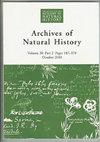“Bharat Singh’s Stuffed Otter”: discovery in 1818 of Ailurus fulgens, the Himalayan red panda
IF 0.3
4区 哲学
Q3 HISTORY & PHILOSOPHY OF SCIENCE
引用次数: 0
Abstract
Thomas Hardwicke’s use of a Nepali vernacular name “Wah” for Ailurus fulgens (red panda, also known as the lesser panda or red bear-cat) in his 1821 report to the Linnean Society of London, and its eventual publication in 1827, has enabled a connection to be made between a mysterious “stuffed otter” found in a Kathmandu bazaar in 1818 and an illustration from Hardwicke’s natural history collection held at the Linnean Society of London. The “stuffed otter” was referred to in letters from Edward Gardner of the British Residency in Kathmandu to Nathaniel Wallich in the Calcutta Botanic Garden. These reveal the seminal role played by Bharat Singh in the realization that this animal was unusual and in his procuring further specimens and ecological information about it from traders in Nepal. Singh was one of Wallich’s plant collectors stationed in Kathmandu and was probably also the source of red panda specimens sent to Paris by Alfred Duvaucel. Duvuacel’s specimens were used by Frédéric Cuvier as the basis of the first scientific description of the species in 1825, which predated that of Hardwicke by two years. The importance of indigenous knowledge in scientific discovery in the Indian subcontinent and role of communication networks are demonstrated. Hidden stories such as these can be uncovered by close scrutiny of archival sources, in this case predominately the Wallich Correspondence at the Acharya Jagadish Chandra Bose Indian Botanic Garden and the Hardwicke material at the Linnean Society of London, and make a significant contribution to the decolonization of collections held in the West.“巴拉特·辛格的水獭标本”:1818年发现喜马拉雅小熊猫Ailurus fulgens
托马斯·哈德威克(Thomas Hardwicke)在1821年给伦敦林奈学会(Linnean Society of London)的报告和1827年最终出版的报告中,使用了一个尼泊尔本土名字“Wah”来命名Ailurus fulgens(小熊猫,也被称为小熊猫或红熊猫),这使得1818年在加德满都集市上发现的神秘“填充水獭”与哈德威克在伦敦林奈学会(Linnean Society of London)收藏的自然历史插图之间建立了联系。英国驻加德满都大使馆的爱德华·加德纳(Edward Gardner)在写给加尔各答植物园的纳撒尼尔·沃利奇(Nathaniel Wallich)的信中提到了“填充水獭”。这些揭示了巴拉特·辛格在意识到这种动物的不寻常以及从尼泊尔商人那里获得更多标本和生态信息方面所发挥的开创性作用。辛格是Wallich驻加德满都的植物收集者之一,他可能也是阿尔弗雷德·迪沃塞尔(Alfred Duvaucel)送到巴黎的小熊猫标本的来源。1825年,弗莱姆·居维叶以迪瓦塞尔的标本为基础,首次对该物种进行了科学描述,比哈德威克早了两年。土著知识在印度次大陆科学发现中的重要性和通信网络的作用被证明。这些隐藏的故事可以通过对档案来源的仔细审查来发现,在这种情况下,主要是阿查里亚·贾格迪什·钱德拉·博斯印度植物园的沃利奇通信和伦敦林奈学会的哈德威克材料,并为西方收藏的非殖民化做出了重大贡献。
本文章由计算机程序翻译,如有差异,请以英文原文为准。
求助全文
约1分钟内获得全文
求助全文
来源期刊

Archives of Natural History
HISTORY & PHILOSOPHY OF SCIENCE-
CiteScore
0.40
自引率
50.00%
发文量
34
审稿时长
>12 weeks
期刊介绍:
Archives of Natural History (formerly the Journal of the Society for the Bibliography of Natural History) publishes peer-reviewed papers on the history and bibliography of natural history in its broadest sense, and in all periods and all cultures. This is taken to include botany, general biology, geology, palaeontology and zoology, the lives of naturalists, their publications, correspondence and collections, and the institutions and societies to which they belong. Bibliographical papers concerned with the study of rare books, manuscripts and illustrative material, and analytical and enumerative bibliographies are also published.
 求助内容:
求助内容: 应助结果提醒方式:
应助结果提醒方式:


